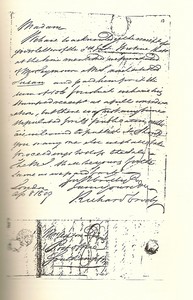This week we have marked the anniversary of the date Jane Austen first became a published author – 30th October 1811. It is easy to assume that a writer as gifted as Jane would not have too many difficulties in publishing her works. But, after two failed attempts, Jane decided the only way to guarantee publication was to take the financial risk herself and pay to be published.
From an early age, Jane wanted to be a published author. She was a prolific writer as a teenager short stories, poems, satires and plays (collectively called her Juvenilia) and it is believed that in 1795, when Jane was twenty years old, she wrote Elinor and Marianne, an epistolary novel in the form of letters from one character to another, the first incarnation of Sense and Sensibility. Like so many ‘facts’ about Jane, this is an assumption based on the available evidence and is subject to conjecture. Unlike Pride & Prejudice (also written originally as an epistolary novel) where the main characters are often apart, the Dashwood sisters are usually together and I find it hard to see how the story would allow for a steady stream of letters.
Elinor and Marianne Dashwood, as portrayed by Emma Thompson and Kate Winslet.
She began writing her second epistolary novel in 1796 and a year later had a finished work she titled First Impressions. On 1st November 1797 Jane’s father approached publisher Thomas Cadell with the manuscript of First Impressions but was ignored. That was probably a blessing, as the maturity and skill Jane brought to the revisions of her earlier manuscripts led to the Pride and Prejudice that has been cherished by readers and academics for two centuries, but Jane would not have known that at the time.
In 1803, George Austen sold the copyright of Susan, Jane’s first complete narrative work for £10 to Benjamin Crosby. I can only imagine how thrilled Jane would have been and I have no doubt the family would have waited in anticipation of its release. But Crosby failed to keep his word and didn’t publish Susan. Six years later in desperation, Jane wrote to Mr Crosby under the pseudonym Mrs Ashley Dennis—M.A.D. for short. She implored him to publish the novel, or she would have no alternative but to seek publication elsewhere:
Wednesday 5 April 1809 68(D). To B. Crosby &.. Co.
Gentlemen
In the Spring of the year 1803 a MS. Novel in 2 vol. entitled Susan was sold to you by a Gentleman of the name of Seymour, 1 & the purchase money £10. reed at the same time. Six years have since passed, & this work of which I avow myself the Authoress, has never to the best of my knowledge, appeared in print, tho’ an early publication was stipulated for at the time of Sale. I can only account for such an extraordinary circumstance by supposing the MS by some carelessness to have been lost; & if that was the case, am willing to supply You with another Copy if you are disposed to avail Yourselves of it, & will engage for no farther delay when it comes into Your hands. — It will not be in my power from particular circumstances to command this Copy before the Month of August, but then, if you accept my proposal, you may depend on receiving it. Be so good as to send me a Line in answer, as soon as possible, as my stay in this place will not exceed a few days. Should no notice be taken of this Address, I shall feel myself at liberty to secure the publication of my work, by applying elsewhere. I am Gentlemen &c &c
MAD–
After only two days, she received a quick response:
Direct to Mrs Ashton Dennis Post office, Southampton
[Messrs. Crosbie [sic] & Co., Stationers’ Hall Court London]
Madam
We have to acknowledge the receipt of your letter of the 5th inst.
It is true that at the time mentioned we purchased of Mr Seymour a MS. novel entitled Susan and paid him for it the sum of 10£ for which we have his stamped receipt as a full consideration, but there was not any time stipulated for its publication, neither are we bound to publish it, Should you or anyone else [sic] we shall take proceedings to stop the sale. The MS. shall be yours for the same as we paid for it.
London Ap 81809
~ Dennis Post Office Southampton.
For B. Crosby & Co I am yours etc.
Richard Crosby
Photo of ms autograph copy of Crosby’s letter (Photo: reveriesunderthesignofausten.wordpress.com)
I could only imagine how frustrated Jane must have been. Jane could have decided not to subject herself to such disappointment and to give up, but she didn’t.
When Jane moved to Chawton in July 1809, her writing had all but stopped (following the death of her father and subsequent home insecurity). Within a month of her arrival, she started writing again, and less that eighteen months later Sense & Sensibility was ready for publication. Despite her limited funds, Jane paid for Sense and Sensibility to be published on commission, which guaranteed that her book would be printed and available for sale – as close to 'self-publishing' as you could get in Jane’s time. The words at the bottom of the title page state 'PRINTED FOR THE AUTHOR'. Jane would share in the profits from any sales of the book but also carry the financial risk if it didn’t sell. Jane backed herself and made a profit of £140 (the equivalent of about £5,000 today)—no doubt a welcome boost to the Austen ladies’ modest income.
Sense & Sensibility was a success and Jane Austen never paid to publish her work again.
And Susan? The family bought back the manuscript from Crosby after Jane died (without revealing it was by the same author as novels such as Pride & Prejudice), for the ten pounds he originally paid, and published Jane's first complete narrative work as Northanger Abbey. How fitting it is that Jane now appears on the ten pound note, but what a shame she didn't know that Susan was eventually published.
Caroline
Caroline Jane Knight is Jane Austen's fifth great-niece and the last Austen to grow up at Chawton House on the ancestral estate where Jane herself lived and wrote. You can read more about Caroline's extraordinary childhood in JANE & ME: MY AUSTEN HERITAGE, available in PAPERBACK, HARDBACK, E-BOOK and AUDIOBOOK at all good online retailers. 15% of any profits made are donated to the Jane Austen Literacy Foundation
SUBSCRIBE TO CAROLINE'S JOURNAL BELOW





